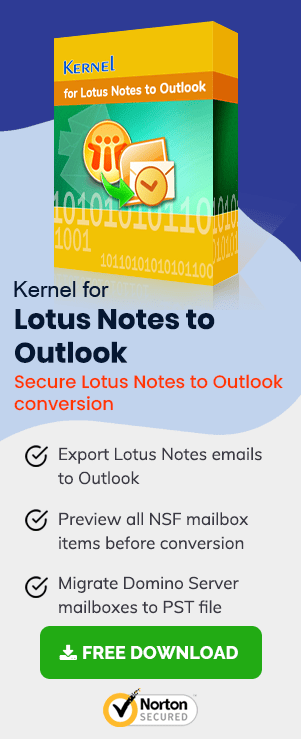IBM Notes email application was in demand at a time, but it gradually lost the interest of users owing to many new, advanced and convenient email clients in the market. Stiff competition for this email client is from the multi-tasker Microsoft Outlook application. Better features, minimum limitations, flexibility, advanced account configurations (including Exchange and cloud), and convenience make Outlook a better option which causes many users to choose wisely between IBM Notes and Microsoft Outlook email clients.
IBM Notes, even after the latest release, has certain issues and limitations. Here, we will be discussing some common IBM Notes problems.
Some Most Common IBM Notes Problems
Meeting Limitations
The Meeting feature in IBM Notes has the following limitations:
- Meeting room invitations in Notes is confusing and messy to some extent. It can cause unnecessary wastage of time.
- There is no flexibility in ensuring the availability of individuals for specific slots of a meeting. The person invited for the meeting will be marked for the entire time of the meeting, rather than for the specific slot for which he needs to be available.
- When a Notes user deletes any meeting invitation, it does not consider the linked files and attachments for automatic deletion. So, the unwanted data still uses storage space causing oversize of the database file.
Inefficient Search Capability
Users experience the following limitations with the mail searching feature:
- Unable to perform a search in multiple archives at the same time
- The advanced search option is almost hidden deep inside menus
- Can do a simple search only – no complex search queries
- Search results cannot be saved
- Search query is limited to the selected folder only
Spell Checker Issues
The spell-checker in Notes is quite frustrating. Even when a user ignores a minor misspelling in the subject line, it continues to check for the same in the message body (unless it is in the dictionary).
Bad Message Handling
Message handling is also a big task in IBM Notes. There are many confusions and restrictions. A few examples are:
- No information about the total number of highlighted messages in a folder
- Unread messages remain in the same order as they received in a mailbox; therefore, difficult to identify them later.
Inadequate Integration With Third-Party Services
IBM Notes has only a loose integration with third-party services. We have listed some common issues related to this:
- Bad integration with internet email clients
- Does not support Outlook well for meeting invitations
- Difficulty in viewing webmail or Google calendar through IBM Notes
Frequent Errors
IBM Notes is vulnerable to many errors like:
- Entry not found in Index
It is a Notes error which comes up when a user tries to configure any user in IBM Notes. This error “Entry Not Found in Index” is due to locally edited policy. This causes disturbance to users in setting up a new user and so needs to be fixed.
Try editing and saving each policy (on names.nsf server replica) individually. - Internet Certificate Signing Issue
A certificate error like “Your current ID does not specify an Internet certificate for signing” generally occurs when a user sets default Notes settings for emails via IBM Notes email ID Public Key Infrastructure. It is using this key that Notes signs in messages to more recipients. However, sometimes, this can cause issues.
To fix the error, you should integrate the X.509 certificate to the Notes email ID and also edit the default settings of authorization messages. - Object store database is disabled
IBM Notes users cannot access Domino Server locally with full freedom as this error “Object store database is disabled” will pop up anytime forcing users to connect to Domino Server and then access its data.
Users can try to connect to the Domino Server and run the tasks collectively to resolve this issue.
There are many other frequent errors that pop up due to corruption in NSF files and can be fixed by repairing the database.
The Slow Rate of Backups
Owing to the IBM Notes’ file structure and sometimes due to large-database size, it would take a long time for getting a backup via the manual procedure. And thus, the backup rate is quite slow and is a cause of annoyance even for regular and long-time users.
Migration from Lotus Notes to Outlook
Because of the complexity and issues of IBM Notes features, settings, and functions, some users have got some good reasons to migrate from IBM Notes to better email clients like Microsoft Outlook.
There are some free methods to convert NSF to PST, but as mentioned the manual way is quite slow and also has risks of data loss. So, we consider avoiding these solutions as it would be a mere waste of time and effort.
And here, comes the role of our efficient software NSF to PST converter which moves data from IBM Notes NSF file to Outlook PST format for further use in the new email client. The tool supports single/multiple local and Domino Server NSF files for migration and offers selective migration through various filter options. It’s one more advantage is that it transfers IBM Notes data to live Exchange Server. And the migration is all easy with this advanced tool.

Conclusion
IBM Notes email client has many limitations like Meeting limitations, Spell check limitations, inefficient search capacities, bad message handling, bad integration with third-party services, frequent errors causing data inaccessibility, etc. Such limitations in IBM Notes can be overcome by performing some native solutions and by migrating to an email client like Outlook as a final solution. That is the reason why many Notes users choose to migrate to Outlook. And for easy migration from Lotus Notes to Outlook, one can try a professional tool like NSF to PST.

